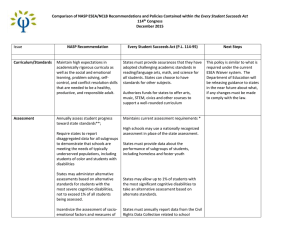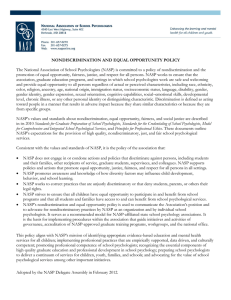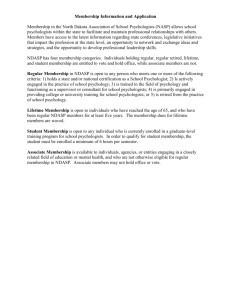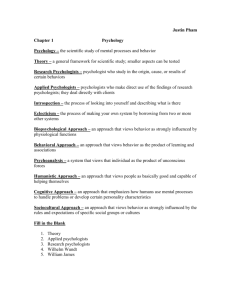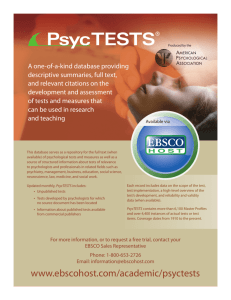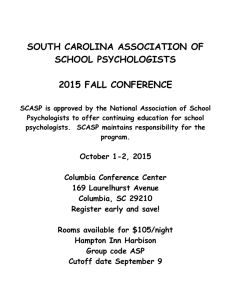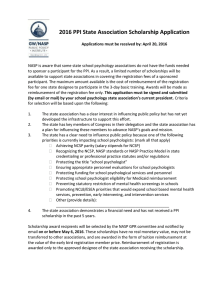Mental Health Services and Integration
advertisement
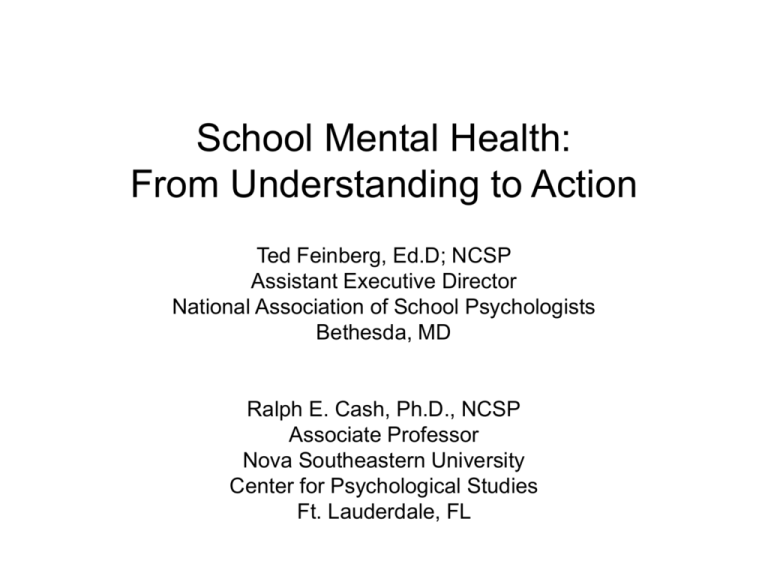
School Mental Health: From Understanding to Action Ted Feinberg, Ed.D; NCSP Assistant Executive Director National Association of School Psychologists Bethesda, MD Ralph E. Cash, Ph.D., NCSP Associate Professor Nova Southeastern University Center for Psychological Studies Ft. Lauderdale, FL “Children are the messages we send to a time we will not see.” (Neil Postman) “...mental health is inexorably linked with general health, child care, and success in the classroom and inversely related to involvement in the juvenile justice system." (U.S. Department of Health and Human Services. Mental Health: A Report of the Surgeon General. Rockville, MD: U.S. Department of Health and Human Services, Substance Abuse and Mental Health Services Administration, Center for Mental Health Services, National Institutes of Health, National Institute of Mental Health, 1999.) “A collaborative and coordinated effort is needed among schools, families, and communities to ensure that all children and adolescents achieve positive academic and behavioral outcomes.” [National Association of School Psychologists (2003), Position Statement on Mental Health Services in the Schools] Both the promotion of mental health in children and the treatment of mental disorders should be major public health goals. -Report of the Surgeon General’s Conference o Children’s Mental Health, 2000 NASP GPR/HCI All children face some mental health problems/issues, including: • • • • • • • • • • • • • Anxiety about school performance Problems dealing with parents & teachers Unhealthy peer pressure Common developmental, adjustment problems Fears about starting school School phobia Dealing with death or divorce Feeling depressed or overwhelmed Drug or alcohol use Suicidal ideation Worrying about sexuality Facing tough decisions Considering dropping out of school NASP GPR/HCI The extent, severity, and far-reaching consequences of mental health problems in children and adolescents make it imperative that our nation adopt a comprehensive, systematic, public health approach to improving the mental health status of children. -The National Advisory Mental Health Council’s Workgroup on Child and Adolescent Mental Health, 2003 NASP GPR/HCI Mental health care should be part of a child’s general health care. We must put mental health on parity with physical health in America ! NASP GPR/HCI Why Choose Schools? • Schools are the logical point of entry to increase the efficacy of mental health services to children and adolescents. • For nearly half of the children with serious emotional disturbances who receive mental health services at all, the school system has been the sole provider. • Schools are already the primary providers of mental health services for all children. • Offering services in the schools improves access to treatment. Other Reasons to Choose Schools Mental health is directly linked to educational outcomes. Schools are the optimal place to develop psychological competence and to teach children about making informed and appropriate choices concerning their health and many other aspects of their lives because schools are the only organization in our society to which virtually all children and adolescents are consistently exposed for extended periods of time. Schools are vital and central community institutions. Other Reasons to Choose Schools As multidisciplinary entities, schools are the best places to integrate and to coordinate the efforts of teachers, families, mental health service providers, and administrators to foster the mental health of students. Accessible, affordable mental health services are most easily and consistently provided in the educational setting. Problems of transportation, accessibility, and stigma are minimized when such services are provided in schools. Basic Beliefs • Students must be safe and healthy to be successful in school. This is supported in NCLB, IDEA and the President’s New Freedom Commission report. • Schools are primary care/public health settings. • Every community has a school district. Basic Beliefs…cont. • Mental health services should be an available component for every child’s school experience. • Schools offer easy access and familiarity to children & families. • Children & teens in this country are in dire need of expanded mental health services according to a variety of reputable sources. Why is Mental Health in Schools an Imperative? • Accessing students and their families who need mental health services is facilitated by contact through and at schools • Addressing psychosocial and mental and physical health concerns is essential to the effective school performance of some students Mental Health in Schools… • Schools can enhance the nature and scope of mental health interventions, fill gaps, enhance effectiveness, address problems early, and reduce stigma. • Schools can positively impact educational outcomes by ensuring that all students are mentally & physically healthy Mental Health in Schools: Meeting the Imperative • Screening and diagnosing psychopathology, providing clinical services, and connecting community mental health providers to schools are useful but not enough ! • Schools need to define mental health broadly and: Meeting the Imperative… • Emphasize mental strengths as well as deficits. • Relate mental health to real-life day-to-day issues. • Enhance the important collaborative partnerships between schools, home & community to serve the educational & emotional needs of students. Meeting the Imperative… • Stress the role mental health in schools can play in ensuring that all students have an equal opportunity to succeed at school. • Seek solutions to the related problems of marginalization, fragmentation, and counterproductive competition for sparse resources. • Address the challenges of evidence-based strategies and achieving results. Meeting the Imperative… • Mental health in schools needs to be a valued part of student support systems that enable students to learn and allow schools to achieve their educational mission. • With a shared agenda, existing resources can be deployed and redeployed in ways that enhance equity with respect to availability, access, and effectiveness. The Cost of Doing Nothing…… Our failure to prevent or intervene early in a child’s mental health problems results in: $ Higher K-12 education costs and dramatically lower graduation rates $ Increased use of expensive “deep-end” mental health services $ Increased health care costs $ An increased number of children in the juvenile justice system & other out-of-home placements $ Suicide - the 3rd leading cause of death among children ages 10 and up NASP GPR/HCI What is the continuum of “School Mental Health” Services? • Universal prevention services provided to all students that seek to promote positive mental health and educational success • Targeted prevention and intervention services that seek to improve social-emotional skills and behaviors linked to positive mental health and educational success • Intensive intervention services that seek to help students effectively cope with social-emotional and behavioral issues that impact positive mental health and educational success Who provides these services and Where are they offered? • School-employed school mental health providers – School counselors, psychologists, social workers, nurses • Community-employed school mental health providers – Counselors, psychologists, social workers, nurses, psychiatrists, child and family therapists – Sensory Arts providers: Music, art, and dance therapists • Through schools, community agencies/networks, faith-based organizations, hospitals, and private providers Essential Elements of Family and Community Involvement • providing time, experience, and resources • supporting student involvement in activities that foster health • ensuring that students and their families receive needed comprehensive health services • planning jointly to develop relevant and appropriate messages and services • delivering clear, consistent messages that support mental health, include high but attainable expectations, and offer appropriate role modeling • sharing facilities and encouraging participation by all relevant individuals and groups. Actions for Schools • Communicate a commitment to family involvement through supportive mission and policy statements. • Provide opportunities for family members to express concerns and share solutions. • Involve parents and other family members in planning, curriculum and policy development, and decision-making related to school mental health. • Reinforce understanding and trusting relationships with families. • Provide training to develop staff skills for encouraging collaboration with families. • Evaluate family involvement activities and adapt them if they are not effective. • Establish frequent, clear communications with families. Actions for Families • Encourage children's healthy behaviors by praising appropriate behaviors and acting as positive role models for children. • Encourage children to adopt good eating and physical activity habits. • Cooperate with schools and others in the community to provide for children's physical and mental health services. • Learn about and reinforce the skills and messages in their children's mental health and physical education curricula and, if uncomfortable with a message, discuss concerns with the school. Actions for Parent Organizations • Determine what components of a coordinated school mental health program exist in school and work with the school and others in the community to strengthen weak components or establish those that are missing. • Distribute notices and handouts throughout the community to inform families and other community members about mental health issues and to garner broader community support. Actions for Community Members • Learn more about the local schools’ mental health programs. • Advocate for school mental health programs by speaking at community forums, writing letters to the editors of local newspapers, lobbying school board members and administrators, and participating in relevant organizations. • Meet with school personnel to determine what support they can offer to advance the school's or district's mental health objectives. Actions for Community Members (continued) • Serve on or initiate a school-community committee for a coordinated school mental health program or a particular component. • Encourage radio and cable television stations to feature programs and activities that inform the community and reinforce mental health messages. • Identify appropriate funding sources or raise funds to support the school mental health program. • Nurture relationships between schools and community organizations that can provide young people with needed physical and mental health services. Actions for School Psychologists and Other School Mental Health Providers • Take the initiative to learn about the schools’ and the district’s mental health service delivery plan • Volunteer to be on or to initiate a steering committee for school-based or school-linked mental health service delivery • Learn about your state’s plan for Medicaid reimbursement for school-based behavioral health services • Lobby for modification of the Medicaid plan if behavioral health services are not included or if school psychologists and relevant others are not eligible providers • Above all, be part of the solution, not part of the problem Joint Actions by Schools, Families, and Other Community Members • Establish and maintain a core school mental health advisory group and ensure that all stakeholders are represented. • Identify a coordinator for school and community mental health. • Inventory community needs, resources, and values. • Establish communication mechanisms that include inviting participation. • Develop and implement an action plan. • Measure progress and outcomes; then celebrate and publicize successes. Actions by State and National Organizations and Institutions of Higher Education • Demonstrate commitment by developing infrastructures that support coordinated school mental health programs, meeting with families and community groups to encourage their support, publicizing innovative models and exemplary programs, and encouraging organizational members and staff to become involved in their children's school mental health programs. • Adopt supportive position statements, policies, and standards. Actions by State and National Organizations and Institutions of Higher Education (continued) • Provide educational opportunities that help school personnel, family members, and others in the community to work together more effectively. • Encourage more active family and community involvement by educating members and constituents about coordinated school mental health programs to become advocates; developing media campaigns; offering grants; collecting, assessing, and sharing resources that help practitioners network with peers in the community; compiling a directory of consultants experienced in working with young people; or sponsoring conferences and supporting publications to disseminate information about exemplary local, state, and national initiatives. Prescription for Success • School-based and school-linked services can be designed to address students' mental health needs using a variety of service options ranging from prevention to intensive intervention. • The key to making mental health services effective is to ensure that they are comprehensive, coordinated, and accessible to students and families. References • Leatherman & McCarthy (2004). Quality of Health Care for Children and Adolescents: A Chartbook. The Commonwealth Fund. • MacKay, A.P., Fingerhut, L.A., & Duran, C.R. (2000).Adolescent Health Chartbook: Health, United States, 2000. Hyattsville, MD: National Center for Health Statistics. • Marx, E. & Wooley, S.F. (Eds.). (1998). Health is Academic: A Guide to Coordinated School Health Programs. New York: Teachers College Press, Education Development Center, Inc. • Nastasi, B.K., Pluymert, K., Varjas, K., & Moore, R.B. (2002). Exemplary mental health programs: School psychologists as mental health service providers. Bethesda, MD. NASP. • Nastasi, B.K. (Ed.). (1998). Mini-Series: Mental Health Programming in Schools and Communities. School Psychology Review, 27 (2). • Position Statement on Mental Health Services in the Schools (2003). Bethesda, MD. NASP. • U.S. Department of Health and Human Services. (1999). Mental Health: A Report of the Surgeon General. Rockville, MD: U.S. Department of Health and Human Services, Substance Abuse and Mental Health Services Administration, Center for Mental Health Services, National Institutes of Health, National Institute of Mental Health. • U.S. Public Health Service. (2000). Report of the Surgeon General's Conference on Children's Mental Health: A National Action Agenda. Washington, DC: U.S. Department of Health and Human Services.
